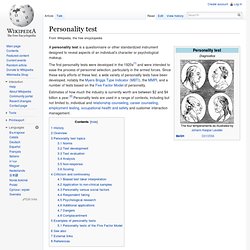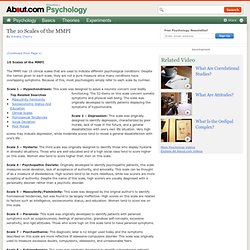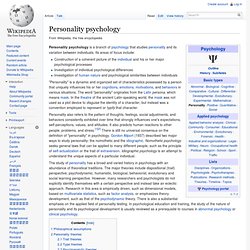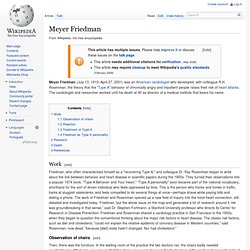

Your True Self Revealed - Fast Fun Free Personality Tests. This is your private report page.

If you wish to share your results with your friends and family, use the links below. You have not saved your results to your account yet. If this is your report page and you wish to save your results, click here to sign in. You are an Advocating Creator. personalDNA about you You are a Creator If you want to be different: how you relate to others You are Advocating Your Personal DNA Maps Here are personalDNA maps that uniquely represent your personality. Advocating Creator To add this map to your website or blog, copy/paste this HTML into the body of a blog post or web page: Your Personality Chart »Glossary of Traits This chart shows thirteen personality traits.
Want to save your report to a personalDNA account? Angelic Human Race - 2012.
Personality test. A personality test is a questionnaire or other standardized instrument designed to reveal aspects of an individual's character or psychological makeup.

The first personality tests were developed in the 1920s[1] and were intended to ease the process of personnel selection, particularly in the armed forces. Since these early efforts of these test, a wide variety of personality tests have been developed, notably the Myers Briggs Type Indicator (MBTI), the MMPI, and a number of tests based on the Five Factor Model of personality. Estimates of how much the industry is currently worth are between $2 and $4 billion a year.[2] Personality tests are used in a range of contexts, including but not limited to, individual and relationship counseling, career counseling, employment testing, occupational health and safety and customer interaction management.
History[edit] Illustration in a 19th-century book depicting physiognomy. Overview[edit]
Online Tests. Personality test based on Jung and Briggs Myers typology. Psychological Testing: Minnesota Multiphasic Personality Inventory - Psychological Testing and Assessment, Neuropsychology and Intelligence Quotient Testing. Wikipedia Updated: Nov 10th 2010 The Minnesota Multiphasic Personality Inventory (MMPI) is one of the most frequently used personality tests in mental health.

The test is used by trained professionals to assist in identifying personality structure and psychopathology. History and development The original authors of the MMPI were Starke R. Hathaway, PhD, and J. The original MMPI was developed in 1939 (Groth Marnat, Handbook of Psychological Assessment, 2009) using an empirical keying approach, which means that the clinical scales were derived by selecting items that were endorsed by patients known to have been diagnosed with certain pathologies.[2][3][4][5][6] The difference between this approach and other test development strategies used around that time was that it was atheoretical (not based on any particular theory) and thus the initial test was not aligned with the prevailing psychodynamic theories of that time.
Current scale composition Clinical scales. The 10 Scales of the MMPI-2. 10 Scales of the MMPI The MMPI has 10 clinical scales that are used to indicate different psychological conditions.

Despite the names given to each scale, they are not a pure measure since many conditions have overlapping symptoms. Because of this, most psychologists simply refer to each scale by number. Myers Briggs Personality Test MBTI Personality Types. Jung type's tests (20 pcs.) [Archive] - Typology Central. Your Gray-Wheelwright-Winer Type Indicator ( test 4 letter type is: Use the following table to understand your raw scores on the Gray-Wheelwright-Winer Type Indicator Test E/I score......E = 2....I = 8 S/N score....S = 5....N = 15 T/F score.....T = 16...F = 4 J/P score.....J = 16...P = 4 Main Characteristics INTJs are the most self-confident of all types, having "self-power" awareness.
![Jung type's tests (20 pcs.) [Archive] - Typology Central](http://cdn.pearltrees.com/s/pic/th/tests-archive-typology-central-11624345)
Psychology. Personality psychology. Personality psychology is a branch of psychology that studies personality and its variation between individuals.

Its areas of focus include: Construction of a coherent picture of the individual and his or her major psychological processesInvestigation of individual psychological differencesInvestigation of human nature and psychological similarities between individuals. Type A and Type B personality theory. Type A and Type B personality theory describes two contrasting personality types that could either raise or lower, respectively, one's chances of developing coronary heart disease.

There is considerable controversy about the role of these personality types in coronary heart disease and the role of tobacco industry funding of early research in this area. History[edit] Type A personality behavior was first described as a potential risk factor for heart disease in the 1950s by cardiologists Meyer Friedman and Ray Rosenman. Minnesota Multiphasic Personality Inventory. The Minnesota Multiphasic Personality Inventory (MMPI) is the most widely used and researched standardized psychometric test of adult personality and psychopathology.[1] Psychologists and other mental health professionals use various versions of the MMPI to develop treatment plans; assist with differential diagnosis; help answer legal questions (forensic psychology); screen job candidates during the personnel selection process; or as part of a therapeutic assessment procedure.[2] The original MMPI, first published by the University of Minnesota Press in 1943, was replaced by an updated version, the MMPI-2, in 1989.

A version for adolescents, the MMPI-A, was published in 1992. An alternative version of the test, the MMPI-2 Restructured Form (MMPI-2-RF), published in 2008, retains some aspects of the traditional MMPI assessment strategy, but adopts a different theoretical approach to personality test development. Psychological typologies. Psychological typologies are classifications used by psychologists to describe the distinctions between people.

The problem of finding the essential basis for the classification of psychological types—that is, the basis determining a broader spectrum of derivative characteristics—is crucial in differential psychology. Historical background[edit] The logic of development of classification hypotheses in psychology[edit] The entire history of human studies from the system-classification position reveals itself as arena of struggle of two opposite methodological directions, the goals of which were: 1) to "catch" the central organizing link, some kind of the motor of all design, and to distribute people by the qualitative specificity of these central links; Meyer Friedman. Meyer Friedman (July 13, 1910–April 27, 2001) was an American cardiologist who developed, with colleague R.H.

Rosenman, the theory that the "Type A" behavior of chronically angry and impatient people raises their risk of heart attacks. The cardiologist and researcher worked until his death at 90 as director of a medical institute that bears his name. Work[edit] Friedman, who often characterized himself as a "recovering Type A," and colleague Dr. Ray Rosenman began to write about the link between behavior and heart disease in scientific papers during the 1950s. Johannes Kepler. Johannes Kepler (German: [ˈkʰɛplɐ]; December 27, 1571 – November 15, 1630) was a German mathematician, astronomer, and astrologer. A key figure in the 17th century scientific revolution, he is best known for his laws of planetary motion, based on his works Astronomia nova, Harmonices Mundi, and Epitome of Copernican Astronomy. These works also provided one of the foundations for Isaac Newton's theory of universal gravitation. During his career, Kepler was a mathematics teacher at a seminary school in Graz, Austria, where he became an associate of Prince Hans Ulrich von Eggenberg.
Later he became an assistant to astronomer Tycho Brahe, and eventually the imperial mathematician to Emperor Rudolf II and his two successors Matthias and Ferdinand II. He was also a mathematics teacher in Linz, Austria, and an adviser to General Wallenstein. Ernst Kretschmer. Ernst Kretschmer, Dr. med. Dr. phil. h.c. (October 8, 1888 – February 8, 1964), was a German psychiatrist who researched the human constitution and established a typology. William Herbert Sheldon. William Herbert Sheldon, Jr. (November 19, 1898 - September 17, 1977) was an American psychologist and numismatist. He created the field of somatotype and constitutional psychology that tried to correlate body types with behavior, intelligence and social hierarchy through his Ivy League nude posture photos.[1] However, his work is generally dismissed by modern researchers.[2] Sigmund Freud.
Sigmund Freud (/frɔɪd/;[2] German pronunciation: [ˈziːkmʊnt ˈfʁɔʏ̯t]; born Sigismund Schlomo Freud; 6 May 1856 – 23 September 1939) was an Austrian neurologist, now known as the father of psychoanalysis. Freud qualified as a doctor of medicine at the University of Vienna in 1881,[3] and then carried out research into cerebral palsy, aphasia and microscopic neuroanatomy at the Vienna General Hospital.[4] Upon completing his habilitation in 1895, he was appointed a docent in neuropathology in the same year and became an affiliated professor (professor extraordinarius) in 1902.[5][6] Psychoanalysis remains influential within psychotherapy, within some areas of psychiatry, and across the humanities.
As such, it continues to generate extensive and highly contested debate with regard to its therapeutic efficacy, its scientific status, and whether it advances or is detrimental to the feminist cause.[10] Nonetheless, Freud's work has suffused contemporary Western thought and popular culture. Id, ego and super-ego. Although the model is structural and makes reference to an apparatus, the id, ego and super-ego are purely symbolic concepts about the mind and do not correspond to actual somatic structures of the brain (such as the kind dealt with by neuroscience).
The concepts themselves arose at a late stage in the development of Freud's thought: the "structural model" (which succeeded his "economic model" and "topographical model") was first discussed in his 1920 essay Beyond the Pleasure Principle and was formalized and elaborated upon three years later in his The Ego and the Id. Freud's proposal was influenced by the ambiguity of the term "unconscious" and its many conflicting uses.
Id[edit] Francis Galton. Consciousness. Psychoanalysis. Resonance. In physics, resonance is the tendency of a system to oscillate with greater amplitude at some frequencies than at others. Frequencies at which the response amplitude is a relative maximum are known as the system's resonant frequencies, or resonance frequencies. At these frequencies, even small periodic driving forces can produce large amplitude oscillations, because the system stores vibrational energy. Forte Communication Style Profile. The Forté Profile is a quantitatively validated communication style profiling instrument.
Big Five personality traits. In psychology, the Big Five personality traits are five broad domains or dimensions of personality that are used to describe human personality. The theory based on the Big Five factors is called the five-factor model (FFM).[1] The five factors are openness, conscientiousness, extraversion, agreeableness, and neuroticism. Genealogy Resources. DDLI. Www.4np.net/ddli/ Www.4np.net/ddli/ How to Identify Ego. Individual's Egos. Spartiate as EGo. Ross Busby as EGO. Humanistic.
Socionics. Social Learning. Enneagram. Temperments. Repertory Grid. Psychopathology. Holland Codes. Behaviorism. Values Scales. Themeatic Apperception. Myers-Briggs. Type A/B. 16 Personality Factors. Proscan. Religious Identifications. Mayan Comsogenises.